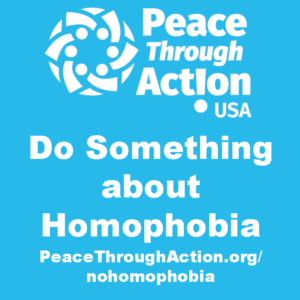What is homophobia?
Homophobia is defined as “irrational fear of, aversion to, or discrimination against homosexuality and homosexuals” (individuals who are attracted to people of the same sex).[1] Homophobia is prejudice or discrimination against individuals who identify as lesbian, gay, bisexual, transgender, or queer (LGBTQIA+) as well as HIV-affected people. Homophobia manifests in a variety of forms including psychological violence, physical violence, intimidation, threats, mobbing, assault, destruction of property, vandalism, intimate partner violence, and a range of discriminatory attitudes.
[1] Homophobia. In Merriam-Webster.com. Retrieved from https://www.merriam-webster.com/dictionary/homophobia
How widespread is homophobia in the United States?
Despite legislation intended to enforce and protect the rights of people who identify as LGBTQIA+, homophobia remains widespread in the United States.
- In recent years, the FBI has reported between 7,000 and 8,000 hate crimes, of which approximately 17.7% are based on homophobia.[2]
- One in five people who identify as LQBTQIA+ have experienced a homophobic hate crime or incident.[3]
- 75% of people who identify as LQBTQIA+ who experience hate crimes did not report them to law enforcement.[4]
- 4 in 10 LGBTQIA+ youth say the community they live in is not accepting of LGBTQIA+ people.[5]
- LGBTQIA+ youth are twice as likely as their peers to say they have been physically assaulted or attacked.[6]
[2] 2015 Hate Crime Statistics Released. FBI. Retrieved from https://www.fbi.gov/news/stories/2015-hate-crime-statistics-released
[3] Ibid.
[4] Ibid.
[5] Growing Up LGBT in America. Human Rights Campaign. Retrieved from http://www.hrc.org/youth-report/view-and-share-statistics
[6] Ibid.
What culture changes and public policies are necessary for preventing homophobia?
The culture changes and public policies that are necessary for preventing or reducing homophobia are those that recognize and protect the civil and human rights of LGBTQIA+ individuals. Social, personal and family acceptance of LGBTQIA+ individuals will influence others to be more supportive and accepting of sexual orientation and gender identity. Critical culture changes and public policies are those that eliminate or reduce bullying in schools, and discrimination in access to health insurance, employment, housing, marriage, adoption, and employment.[7] LGBTQIA+ inclusive education in schools and public services can similarly help to foster understanding and empathy. Additionally, initiatives to promote accessible mental health services that address the unique experiences of LGBTQIA+ people can provide vital support.
[7] Lesbian, Gay, Bisexual, and Transgender Health. Office of Disease Prevention and Health Promotion. Retrieved from https://www.healthypeople.gov/2020/topics-objectives/topic/lesbian-gay-bisexual-and-transgender-health/national-snapshot.
What practical solutions are effective for preventing homophobia?
There are many peaceful practices and peaceful solutions that are known to be effective or considered to be promising for preventing or reducing aggression/violence resulting from homophobia. One approach is educating people about LGBTQIA+ issues and showing your support at gay pride parades and through political activism. Reach out to schools, political leaders, and community-based organizations to voice your concern about homophobic violence or incidents in your community. Consider volunteering, donating, or participating in LGBTQIA+ organizations that promote equity and provide important resources. Speak up against homophobia when you encounter it and amplify the voices of LGBTQIA+ people and their stories to raise awareness and social understanding.
What can I do to prevent or stop homophobia?
Below are several “common sense” actions you can take to in response to homophobic aggression/violence or if one is experiencing or witnessing the form of aggression/violence.
- Use your voice! Write to your community, state, and national leaders and politicians to show your support for legislation that protects victims of homophobia.
- Speak openly about with family, friends, and colleagues and be supportive – homophobia can affect anyone, regardless of their sexual orientation.
- If you are experiencing violence, the Anti-Violence Project offers a crisis intervention hotline staffed 24/7 by trained counselors. Call 212-714-1141
- In case of emergency—If you are experiencing or witnessing an emergency, call 911 or try to get to a location where others can observe your distress and intervene.
Where can I find statistics about homophobia?
For statistics from the Human Rights Campaign’s youth survey, go to http://www.hrc.org/youth-report/view-and-share-statistics
Where else might I go to learn more about homophobia?
- PFLAG—for parents, families, and allies of the LGBTQIA+ community
- Southern Poverty Law Center—Ten Ways to Fight Hate: A Community Response Guide
- Human Rights Campaign—America’s largest civil rights organization working to achieve LGBTQIA+ equality
- The Trevor Project—provides crisis intervention and suicide prevention for LGBTQIA+ youth
- Stop Bullying—how to create a safe environment for LGBTQI+ Youth
- Centers for Disease Control and Prevention (CDC)—how to support LGBTQ youth
Information Sheet-Do Something-Homophobia (PDF)
Have a suggested improvement to this information sheet? Send it to inbox@peacethroughaction.org
Do Something Right Away to Increase Peace
Subscribe to our YouTube channel
Give a gift of money to support our mission delivery activities
Choose opportunities to take part in our #PeaceBeginsWithWe campaign

